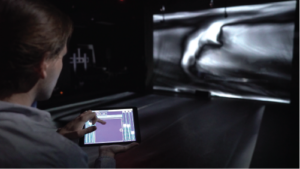Research
An Experiential Model of the Atmosphere
In “Who Has Been the Wind?”, participants can interact with atmospheric phenomena using full-body gestures.
Experiencing Atmospheric Physics

In addition to interacting with spatial variables using gestural interaction, participants can use a mobile or kiosk interface to manipulate global parameters, such as gravity, altitude, simulation speed, or spatial resolution.
Synthesis researchers collaborated with researchers from the Computational Information Systems Laboratory at the National Center for Atmospheric Research (NCAR) to construct a responsive simulation of atmospheric dynamics based on existing idealized models. In addition to featuring a simulation that can operate at high resolutions and responsive frame rates, EMA is a testbed for developing sensing and feedback mappings to allow users to manipulate dynamic, spatial variables such as wind flow velocity, pressure, temperature, and moisture content using full-body interaction.
EMA is part of the Experiential Complex Systems research stream in Synthesis. ECS seeks to develop new ways scientists can interact with computational models outside the computer screen and into an environment where they can move within the simulation and steer it at responsive rates, using motion or ad-hoc or ordinary (chip-less) objects to parameterize the model, provide boundary conditions, and exogenous input, such as sources and sinks within simulated fields.
The Experiential Models of the Atmosphere project consists of both an informal educational exhibit, “Who Has Been the Wind?”, and a portable system that can be used as a research and educational tool for learning about specific atmospheric processes and experimenting with necessary conditions for creating phenomena such as the convection, orographic lift, monsoons, storm fronts, and cyclones. In addition to the embodied, multi-sensory experience implemented in the School of Arts, Media, and Engineering’s Intelligent Stage (iStage), the simulation is designed to be easily portable between different environments.
Synthesis Center Researchers
Brandon Mechtley: Simulations Lead | Synthesis
Connor Rawls: Media Systems Development | Synthesis
Ben Nandin: Responsive Sound Design | Synthesis
Sha Xin Wei: Director | Synthesis
Outside Collaborators
Christopher Roberts: Former Research Director | Center for Scholarship and Research Engagement, Regis University
Melissa Bukovsky: Scientific Advising | National Center for Atmospheric Research
Linda Mearns: Scientific Advising | National Center for Atmospheric Research
Randy Russell: Educational Technology Advising | UCAR Center for Science Education
Dehlia Hannah: Former Research Curator | School for the Future of Innovation and Society
